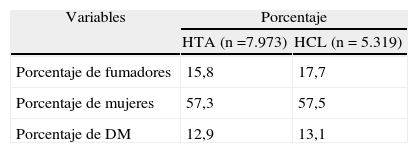En el estudio Mediterránea se cuantifica la situación de riesgo cardiovascular alto (RCVA), la fiabilidad entre REGICOR (R) y SCORE bajo riesgo (SB), las cifras alteradas de presión arterial (APA) en hipercolesterolemia (HCL) sin antecedentes de hipertensión arterial (HTA), o valores altos de colesterol total (ACT) en HTA sin antecedentes de HCL, y en los hipertensos la afectación renal y cardiaca.
Pacientes y métodoDiseño transversal multicéntrico de ámbito nacional. Participaron 751 médicos que individualizadamente valoraron 7.973 pacientes con HTA y 5.319 con HCL. Se definió RCVA a partir del 10% con R y del 5% con SB. Se calculó el coeficiente de correlación intraclase (CCI) y Pearson (r). Se cuantificaron los porcentajes de APA y ACT. En HTA se analizaron las cifras de creatinina (Cr), la tasa de filtrado glomerular por Cockroft-Gault (CG) y el conocimiento de hipertrofia ventricular izquierda (HVI).
ResultadosEn HTA: el 17,3% de RCVA con R y el 26,1% con SB; CCI=0,222 (p<0,0001), r=0,61 (p<0,0001), el 64,7% de ACT, el 31,2% de no valoración de HVI y el 5,1% de prevalencia, el 4,7% y el 1,6%, respectivamente, de lesión e insuficiencia renal (IR) por Cr y el 15,9% IR por CG. En HCL: el 21,1% de RCVA con R y el 21,5% con SB; CCI=0,190, (p<0,0001), r=0,64 (p<0,0001) y el 33,7% de APA.
ConclusionesLa escala SCORE identifica más pacientes con RCVA que la de REGICOR en HTA y parecido en HCL. Entre ambas escalas la fiabilidad es baja. Se cuantifica una importante APA/ACT. En HTA la no valoración de HVI y el porcentaje de IR son considerables.
The Mediterranean study quantifies high cardiovascular risk (HCR), consistency between REGICOR (R) and low risk SCORE (LS) scales, altered blood pressure (ABP) values in hypercholesterolemia (HC) without any history of hypertension (HT), high total cholesterol (HTC) values with HT with no background of HC and cardiac and renal damage in hypertensive patients.
Patients and methodsA national, cross-sectional and multicenter study was performed with the participation of 751 physicians. The physicians individually evaluated 7,973 patients with HT and 5,319 with HC. HCR was defined as over 10% with R and 5% with LS. Intra-class correlation coefficient (ICC) and Pearson coefficient (r) were calculated. The percentages of ABP and HTC were quantified. Creatinine (cr) value, glomerular filtration rate using Cockroft-Gault (CG), and prevalence of left ventricular hypertrophy (LVH) were analyzed.
ResultsRegarding hypertensive patients: 17.3% HCR with R and 26.1% with LS. ICC=0.222 (p<0.0001), r=0.61 (p<0.0001), 64.7% HTC. There was no evaluation of LVH in 31.2% and a prevalence of 5.1%, prevalence of lesion and kidney failure (KF) of 4.7% and 1.6% respectively based on CR and 15.9% KF by CG.
In HC patients, there was 21.1% of HCR with R and 21.5% with LS; ICC=0.190 (p<0.0001), r=0.64 (p<0.0001) and 33.7% ABP.
ConclusionsThe SCORE scale identifies more patients with HCR than the REGICOR one in HT patients and a similar amount in HC patients. Consistency between both scales is poor. A significant ABP/HTC was found. In HT patients, the patients who were not evaluated for LVH and the percentage of KF are important.
Article
Diríjase desde aquí a la web de la >>>FESEMI<<< e inicie sesión mediante el formulario que se encuentra en la barra superior, pulsando sobre el candado.

Una vez autentificado, en la misma web de FESEMI, en el menú superior, elija la opción deseada.

>>>FESEMI<<<










